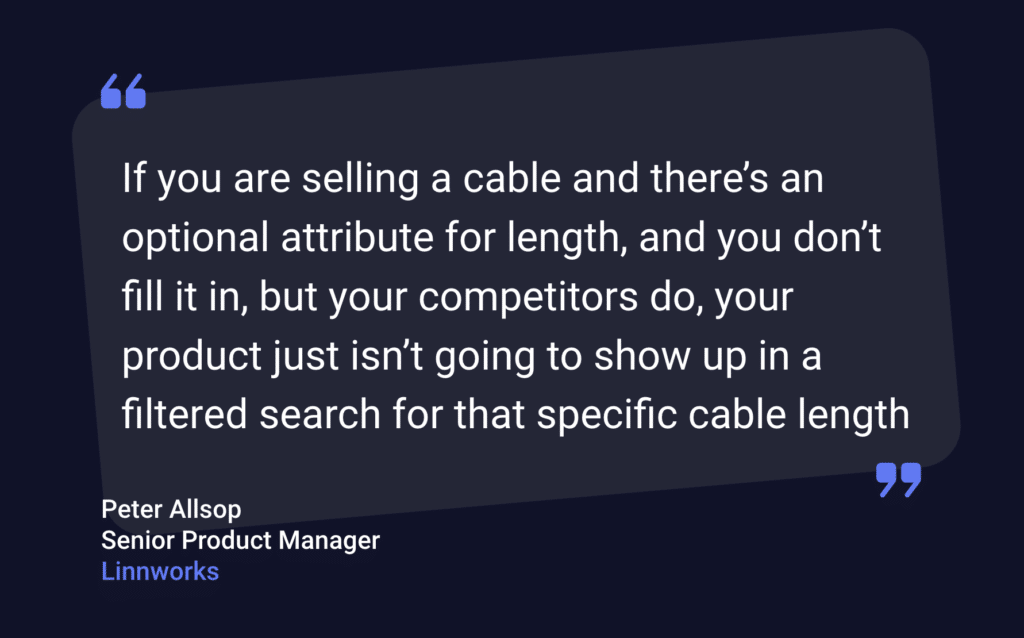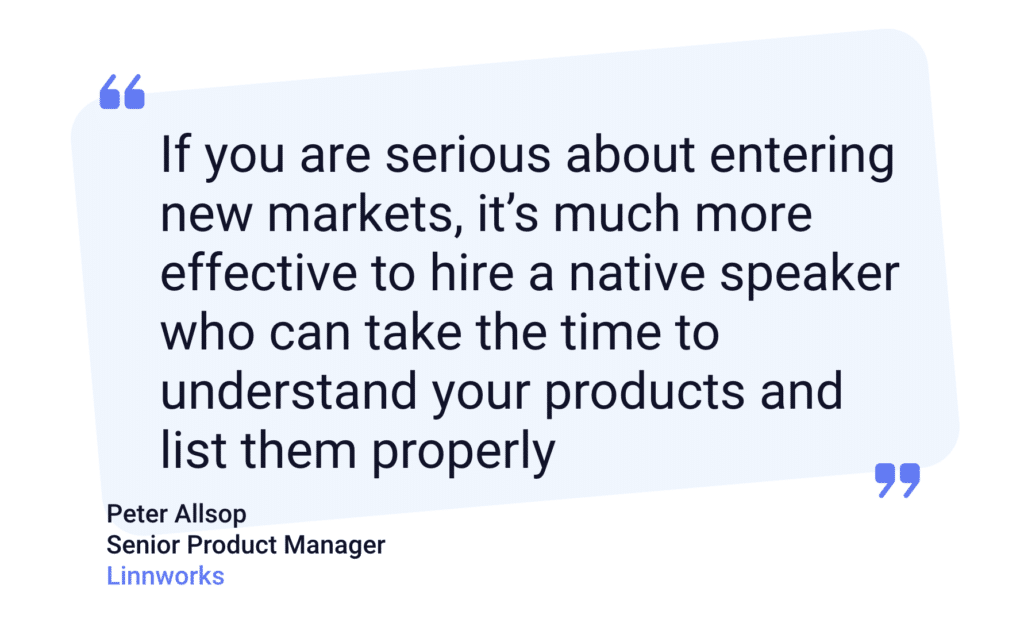How do you create the perfect product listing?
Your success as an online retailer begins and ends with the quality of your product listings. Whether selling on an online marketplace like eBay or Amazon or via your own ecommerce store, a high-quality listing will enhance your visibility, build consumer trust, and boost conversions.
Conversely, a badly listed item will rank poorly in search, potentially never being found by your customers, and damage your entire go-to-market strategy.
While creating optimized product listings should be a priority for all online sellers, the process can be time-consuming and sometimes challenging.
So, how do you create the perfect listing?
We spoke with Peter Allsop, Senior Product Manager at Linnworks, to understand what a good product listing looks like and how online sellers can commit to a program of creating perfect listings across multiple channels.
What makes the perfect listing?


The perfect listing is made up of good data.
“The difference between a good and a bad product listing is the quality of the data used to create that listing,” says Allsop.
Depending on the channel you are selling on, that data will contain visible elements like the product title, description, images, and details relating to the listing template. That data will also include a set of hidden attributes that help the various marketplaces refine the search process and help customers find the right product quickly and efficiently.
“It’s a challenge,” says Allsop. “Your content needs to be meaningful and concise. It can’t be full of ‘waffle’ because people just won’t read it. You’ve got to ensure it contains all the information people need to make a buying decision. But you must also ensure it reads well and makes sense from a human perspective.”
The problem with your suppliers data
Retailers cannot rely exclusively on their suppliers’ product data.
“Your suppliers will give you data, but you’ve really got to screen that information,” says Allsop. “Depending on the supplier, the data may be littered with spelling mistakes and confusing sentence structure.”
Even well-known brands’ data can be problematic.
“An Australian footwear supplier will describe a ‘flip-flop’ shoe as a ‘thong,'” says Allsop. “If you list a flip-flop as a thong in the UK, people aren’t going to know what you are talking about, and your listing might appear in completely the wrong place.”
Essential attributes


Attributes are an essential element of any listing. Depending on the product category you are selling, these include details like size, color, brand, and any technical specifications.
“Ensuring you fill in as many of these attributes as possible is critical,” says Allsop. “This creates good quality data to deliver highly relevant search results.”
Failing to include any optional attributes may result in your products not being found.
“If you are selling a cable and there’s an optional attribute for length, and you don’t fill it in, but your competitors do, your product just isn’t going to show up in a filtered search for that specific cable length,” says Allsop.
Many retailers don’t fully appreciate how their potential customers search for products.
“The stats are really interesting,” says Allsop. “Most retailers assume their customers use the search bar. But a hell of a lot of people use filters and scroll through products. If you’re not using those attributes, your product won’t be included in that selection.”
High-quality images
High-quality product images are another essential element of your product listings.
“In my experience, 99% of the time, suppliers don’t give retailers the best quality images,” says Allsop. “To create a great listing, you really need to enhance what your supplier has given you.”
As well as photographing your products from every conceivable angle – “a product like a smartphone has six sides” – it’s also considered good practice to include additional images of the product in use.
“A client told me they had multiple requests from potential customers to see an image of a fire pit they were selling in use,” says Allsop. “It was imperative to those customers to see the item used in a garden setting before making a buying decision.”
Good images not only help your customers make an informed buying decision but also dramatically improve your visibility across the various online marketplaces.
Images are particularly important on eBay. Depending on the category you are selling in, eBay recommends sellers include between six and 12 shots for every product and allows sellers to add up to 24 images to each product listing. Failure to include enough pictures may result in your listings not appearing in eBay search.
Hiring outsourced help
Due to the time and effort it takes to create perfect listings, many retailers employ third-party contractors to create their listings. According to Allsop, this is not the best route forward.
“If you’re using a third party, you would typically give them a flat-file sheet with all your product details on and grant them access to your listing software,” says Allsop. “They will often just take the basic data they’ve got and create a listing as best they can. In my experience, they won’t edit or curate anything, even though they often say they do. “
If essential data is missing, many third-party suppliers will just guess the information required for a particular field.
“I’ve seen some pretty bad guesses,” says Allsop. “Customers have shown me listings where third-party suppliers have pre-filled in things that don’t necessarily make sense or just aren’t true, which is even worse.”
This misinformation may mean that products are never found or potentially purchased in error, leading to customer dissatisfaction and returns.
“The problem with hiring contractors to create your listings is that they don’t really care about your business,” says Allsop. “They don’t buy the product. They might not even be sure what the product is. There is a huge opportunity for them to get it wrong.”
Lost in translation


The problem of poor listing quality is often compounded when retailers expand internationally.
“They’ll put their listing through Google Translate, or they’ll pay a company to do it and get the translation back in less than 20 minutes,” says Allsop. “Either way, the quality just isn’t there.”
Ultimately, many translation agencies struggle to meet the retailer’s expectations.
“Most of them fall back far too quickly on automatic translation because they can’t keep up with capacity,” says Allsop. “If you are serious about entering new markets, it’s much more effective to hire a native speaker who can take the time to understand your products and list them properly.”
Finding the right person to create your listings
While product listing isn’t a difficult job, it carries a significant responsibility. However, a good product lister will require a specific set of skills.
“You’ll need someone with good local language skills,” says Allsop. “They’ll need to be good with spelling, grammar, and that sort of thing. It will also help if they are familiar with your products. That might require some training.”
While hiring a dedicated person to list your products will add costs, the return on investment can be significant.
“I’ve seen a seller go from shipping 300 items a week to more than 300 items a day just by fixing poor quality listings,” says Allsop. “This happened virtually overnight and really demonstrates the importance of high-quality data.”
How does Linnworks help?
Linnworks helps online retailers collate and configure all of their product data, enabling them to quickly and efficiently list to multiple tier-one online marketplaces and ecommerce platforms.
“In Linnworks, we have something called a configurator, which is basically a master template for each channel a retailer wants to sell on,” says Allsop. “So you select a category, and it will give you the attributes relative to that category.”
Once all the data has been entered, Linnworks checks for errors and highlights any missing information.
“The various marketplaces tell us what attributes are required, what’s optional, what the valid values are,” says Allsop. “We highlight any problems so the user can correct the data, and then, when everything is OK, they can go ahead and list.”
To learn more about how Linnworks can help online sellers optimize their listing process and better manage stock movements and shipping across multiple marketplaces, ecommerce sites, and couriers, contact us today or request a demo.

